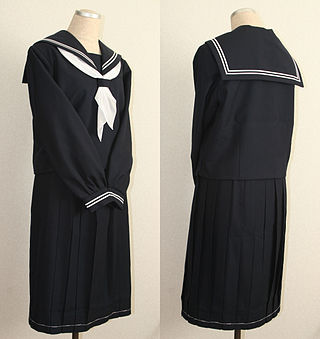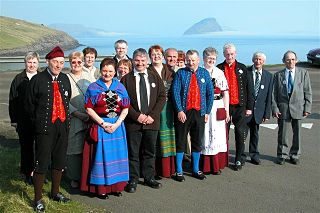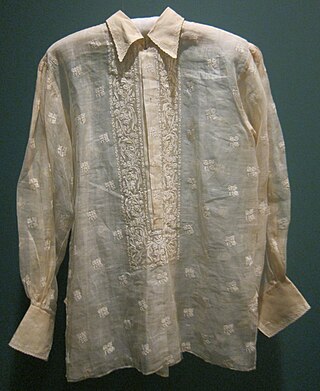
The Japanese school uniform is modeled in appearance similar to that of the European-style naval uniforms. It was first used in Japan in the late 19th century, replacing the traditional kimono. Today, school uniforms are common in many of the Japanese public and private school systems. The Japanese word for this type of uniform is seifuku (制服).

Mariachi is a genre of regional Mexican music that dates back to at least the 18th century, evolving over time in the countryside of various regions of western Mexico. The usual mariachi group today consists of as many as eight violins, two trumpets and at least one guitar, including a high-pitched vihuela and an acoustic bass guitar called a guitarrón, and all players taking turns singing lead and doing backup vocals.

A sombrero is a type of wide-brimmed Mexican men's hat used to shield the face and eyes from the sun. It usually has a high pointed crown, an extra-wide brim that is slightly upturned at the edge, and a chin strap to hold it in place.

Charro, in Mexico, is historically the horseman from the countryside, the Ranchero, who worked on the haciendas and rural areas performing all his tasks on horseback, working as vaqueros and caporales, among other jobs. He was renowned for his superb horsemanship, for his skill in handling the lasso, and for his unique costume designed especially for horseback riding. Today, this name is given to someone who practices charreada, considered the national sport of Mexico which maintains traditional rules and regulations in effect from colonial times up to the Mexican Revolution.

A folk costume expresses an identity through clothing or costume, which is usually associated with a geographic area or a period of time in history. It can also indicate social, marital or religious status. If the costume is used to represent the culture or identity of a specific ethnic group, it is usually known as ethnic costume. Such costumes often come in two forms: one for everyday occasions, the other for traditional festivals and formal wear. The word "costume" in this context is sometimes considered pejorative due to the multiple senses of the word, and in such cases "regalia" can be substituted without offense.

Jarabe tapatío, often referred to as the Mexican hat dance, is the national dance of Mexico. It originated as a courtship dance in Guadalajara, Jalisco, during the 19th century, although its elements can be traced back to the Spanish zambra and jarabe gitano, which were popular during the times of the viceroyalty. Female dancers traditionally wear a china poblana outfit, while the male dancers dress as charros.

A petticoat or underskirt is an article of clothing, a type of undergarment worn under a skirt or a dress. Its precise meaning varies over centuries and between countries.

The barong tagalog, more commonly known simply as barong, is an embroidered long-sleeved formal shirt for men and a national dress of the Philippines. Barong tagalog combines elements from both the precolonial native Filipino and colonial Spanish clothing styles. It is traditionally made with sheer textiles (nipis) woven from piña or abacá; although in modern times, cheaper materials like organza silk, ramie or polyester are also used.

Charrería is a sport and discipline arising from equestrian activities and livestock traditions used in the haciendas of old Mexico.

Western wear is a category of men's and women's clothing which derives its unique style from the clothes worn in the 19th century Wild West. It ranges from accurate historical reproductions of American frontier clothing, to the stylized garments popularized by Western film and television or singing cowboys such as Gene Autry and Roy Rogers in the 1940s and 1950s. It continues to be a fashion choice in the West and Southwestern United States, as well as people associated with country music or Western lifestyles, for example the various Western or Regional Mexican music styles. Western wear typically incorporates one or more of the following, Western shirts with pearl snap fasteners and vaquero design accents, blue jeans, cowboy hat, a leather belt, and cowboy boots.

Fashion in the 1990s was defined by a return to minimalist fashion, in contrast to the more elaborate and flashy trends of the 1980s. One notable shift was the mainstream adoption of tattoos, body piercings aside from ear piercing and, to a much lesser extent, other forms of body modification such as branding.

Fashion of the 1980s was characterized by a rejection of 1970s fashion. Punk fashion began as a reaction against both the hippie movement of the past decades and the materialist values of the current decade. The first half of the decade was relatively tame in comparison to the second half, which was when apparel became very bright and vivid in appearance.

Baile folklórico, "folkloric dance" in Spanish, also known as ballet folklórico, is a collective term for traditional cultural dances that emphasize local folk culture with ballet characteristics – pointed toes, exaggerated movements, highly choreographed. Baile folklórico differs from danzas and regional bailes. Although it has some association from “danzas nationalists". Folk dances", that is, "dances that you will find in the villages, not on stage" were researched and disseminated by Alura Angeles de Flores. Each region in Mexico, the Southwestern United States and Central American countries is known for a handful of locally characteristic dances.

Fashion in the years following World War II is characterized by the resurgence of haute couture after the austerity of the war years. Square shoulders and short skirts were replaced by the soft femininity of Christian Dior's "New Look" silhouette, with its sweeping longer skirts, fitted waist, and rounded shoulders, which in turn gave way to an unfitted, structural look in the later 1950s.

Pakaian is the term for clothing in Malaysia's national language. It is referring to things to wear such as shirts, pants, shoes etc. Since Malaysia is a multicultural nation: Malay, Chinese, Indian and hundreds of other indigenous groups of Malay peninsula and Borneo, each has its own traditional and religious articles of clothing all of which are gender-specific and may be adapted to local influences and conditions. Previously, traditional clothes were worn daily. However, by excluding Baju Melayu, Baju Kurung many are now only worn on special occasions such as marriage ceremonies and cultural events.

Shalwar kameez is a traditional combination dress worn by women, and in some regions by men, in South Asia, and Central Asia.

The 2010s were defined by hipster fashion, athleisure, a revival of austerity-era period pieces and alternative fashions, swag-inspired outfits, 1980s-style neon streetwear, and unisex 1990s-style elements influenced by grunge and skater fashions. The later years of the decade witnessed the growing importance in the western world of social media influencers paid to promote fast fashion brands on Pinterest and Instagram.
Charro Days, also known as Charro Days Fiesta or Charro Days Festival, is a two-nation fiesta and an annual four-day pre-Lenten celebration held in Brownsville, Texas, United States in cooperation with Matamoros, Tamaulipas, Mexico. The grito—a joyous Mexican shout—opens the festivities every year. This festival is a shared heritage celebration between the two border cities of Brownsville, Texas and Matamoros, Tamaulipas. The Charro Days festivals usually have about 50,000 attendees each year. This celebration includes the Sombrero Festival as well as a parade that goes down Elizabeth St. through Historic Downtown Brownsville, TX.

Folk dance of Mexico, commonly known as baile folklorico or Mexican ballet folk dance, is a term used to collectively describe traditional Mexican folk dances. Ballet folklórico is not just one type of dance, it encompasses each region's traditional dance that has been influenced by their local folklore and has been entwined with ballet characteristics to be made into a theatrical production. Each dance represents a different region in Mexico illustrated through their different zapateado, footwork, having differing stomps or heel toe points, and choreography that imitates animals from their region such as horses, iguanas, and vultures.

Fashion and clothing in the Philippines refers to the way the people of the Philippine society generally dress up at home, at work, travelling and during special occasions.




















